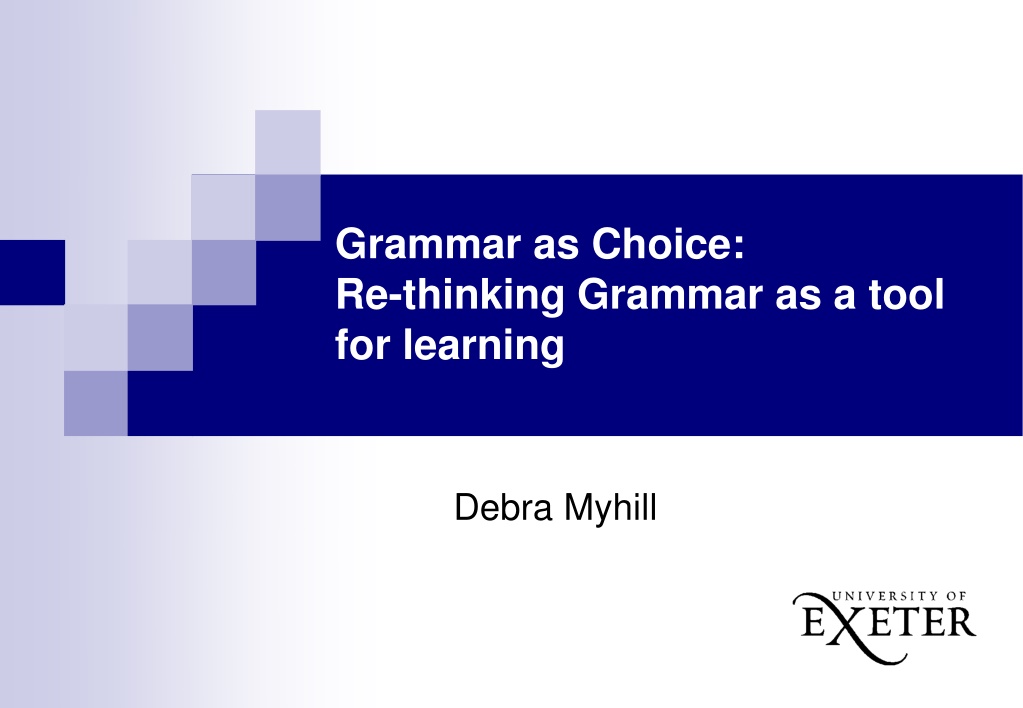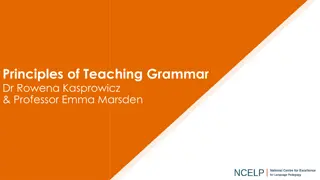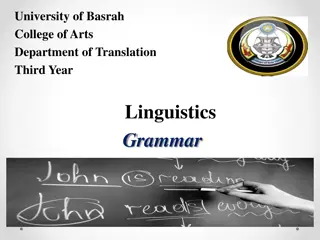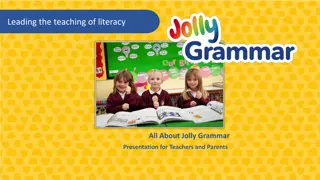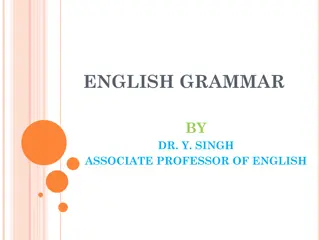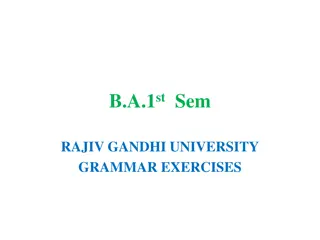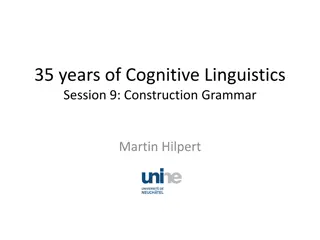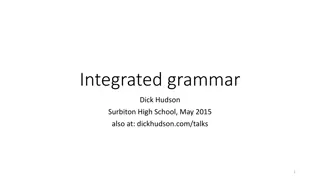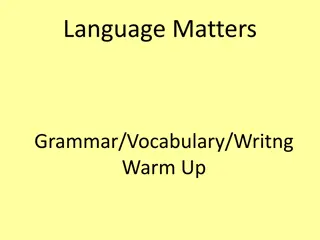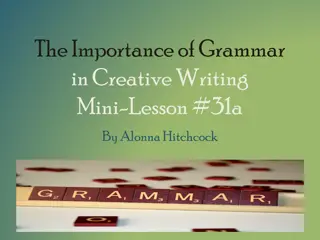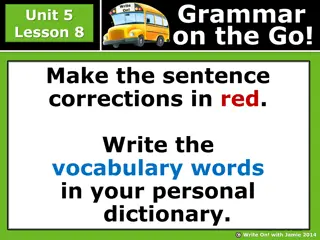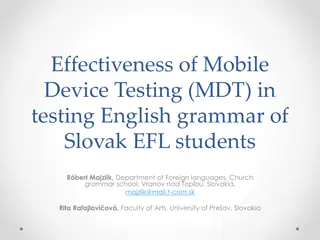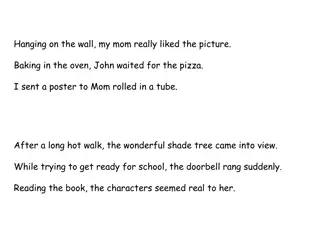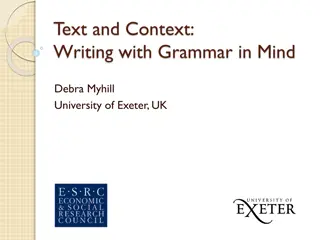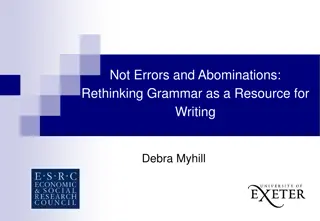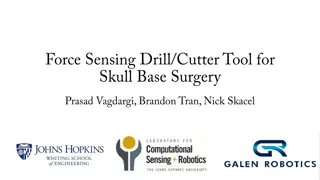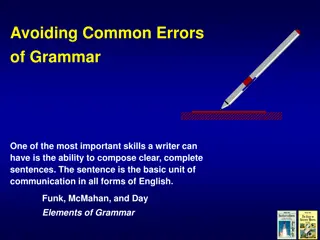Grammar as a Tool for Learning and Communication
Rethinking the role of grammar in education, this discussion explores the shift in focus from learning product to learning process, driven by concerns about English teaching. The evolution of grammar teaching post-Dartmouth Conference is examined, highlighting the ongoing debate between grammar for error correction versus grammar for creativity. The National Curriculum in England emphasizes the teaching of grammar to enhance language control and usage, promoting Standard English while allowing for teacher creativity.
Download Presentation

Please find below an Image/Link to download the presentation.
The content on the website is provided AS IS for your information and personal use only. It may not be sold, licensed, or shared on other websites without obtaining consent from the author.If you encounter any issues during the download, it is possible that the publisher has removed the file from their server.
You are allowed to download the files provided on this website for personal or commercial use, subject to the condition that they are used lawfully. All files are the property of their respective owners.
The content on the website is provided AS IS for your information and personal use only. It may not be sold, licensed, or shared on other websites without obtaining consent from the author.
E N D
Presentation Transcript
Grammar as Choice: Re-thinking Grammar as a tool for learning Debra Myhill
Grammar: in Anglophone countries Dartmouth Conference (US) 1966: a meeting of about 50 educationalists, largely from the UK and US for a 3 week seminar on English teaching; driven by growing concerns about the teaching of English; focused very heavily on writing and grammar; The outcome was a shift in attention from learning product to learning process, and other changes based on the British growth model for viewing the discipline of English (Smagorinsky 2002:23). Thus, a seminal moment for grammar as it triggered a large-scale rejection of grammar teaching by educationalists and teachers.
Grammar: in Anglophone countries Since the Dartmouth conference, for over 50 years, the role of grammar in language learning has divided professional and policymaker perspectives: grammar does not help language users to use language better; grammar is about error correction and accuracy; grammar and creativity are opposed: grammar = rules; creativity = freedom; grammar is the cure for social ills! Generally more ideological than informed debate. Nothing helps your writing so much as ignoring grammar (Elbow 1981)
National Curriculum 2014: England Pupils should be taught to control their speaking and writing consciously and to use Standard English. They should be taught to use the elements of spelling, grammar, punctuation and language about language listed. This is not intended to constrain or restrict teachers creativity, but simply to provide the structure on which they can construct exciting lessons. A non-statutory Glossary of terms is provided for teachers. Throughout the programmes of study, teachers should teach pupils the vocabulary they need to discuss their reading, writing and spoken language. It is important that pupils learn the correct grammatical terms in English and that these terms are integrated within teaching.
National Curriculum: England The grammar of our first language is learnt naturally and implicitly through interactions with other speakers and from reading. Explicit knowledge of grammar is, however, very important, as it gives us more conscious control and choice in our language. Building this knowledge is best achieved through a focus on grammar within the teaching of reading, writing and speaking. Once pupils are familiar with a grammatical concept [for example modalverb ], they should be encouraged to apply and explore this concept in the grammar of their own speech and writing and to note where it is used by others. Young pupils, in particular, use more complex language in speech than in writing, and teachers should build on this, aiming for a smooth transition to sophisticated writing.
NC: KEY STAGE 3 Read critically: knowing how language, including figurative language, grammar, text structure and organisational features present meaning; Write accurately, fluently, effectively and at length through: applying their growing knowledge of vocabulary, grammar and text structure to their writing and selecting the appropriate form; drawing on knowledge of literary rhetorical devices from their reading and listening to enhance the impact of their writing; amending the grammar and structure of their writing to improve its coherence and overall effectiveness Consolidate and build on their knowledge of grammar and vocabulary through: studying the effectiveness and impact of the grammatical features of the texts they read drawing on new vocabulary and grammatical constructions from their reading and listening, and using these consciously in their writing and speech to achieve particular effects
Grammar in the US Common Core Language Standard 1 requires command of the conventions of standard English grammar and usage when writing or speaking Language Standard 2 requires command of the conventions of standard English capitalization, punctuation, and spelling when writing . Language Standard 3 requires students to understand how language functions in different contexts, to make effective choices for meaning or style, and to comprehend more fully when reading or listening , and that students must also be able to make informed, skilful choices among the many ways to express themselves through language (CCSSI 2012).
Grammar in the Australian Curriculum Element 1: Language: Knowledge about the English language: a coherent, dynamic, and evolving body of knowledge about the English language and how it works. (ACARA 2009:1). The goal of teaching grammar and textual patterns should go beyond students labelling of various grammatical categories; it should centre on goals such as clearer expression of thought, more convincing argumentation, more careful logic in reasoning, more coherence, precision, and imagination in speaking and writing, and knowing how to choose words and grammatical and textual structures that are more appropriate to the audience or readership. The goal here centres on the gradually more powerful conversion of knowledge about language into a resource for effective reading, listening, viewing, writing, speaking and designing. (ACARA 2009: 6) They need to be able to talk systematically in informed ways about the nature and consequences of the choices they have made in their expressions. (ACARA 2009:10)
At the start of this new millennium, throughout much of the K-12 English curriculum, grammar is a broken subject Grammar is often ignored, broken off altogether from the teaching of literature, rhetoric, drama, composition, and creative writing. Grammar is the skunk at the garden party of the language arts. (Haussamen 2003 px)
The Grammar Test: England
Grammar in the Curriculum Why teach grammar? To understand the structure of your own language? To avoid making mistakes in speaking and writing your own language? To develop understanding about how texts work and make meaning? To make you a better reader and writer?
RESEARCH ON GRAMMAR TEACHING
Research on Grammar Teaching Meta-analyses: Braddock, Lloyd-Jones and Schoer (1963): he argued grammar had a harmful effect on the development of original writing (1963:37). Hillocks (1984) and Hillocks and Smith (1991) reiterated the view that there was no evidence for a beneficial effect. EPPI 2004: no evidence of any beneficial impact. Graham and Perin 2007: a negative effect for the explicit and systematic teaching of the parts of speech and structure of sentences (2007:21) Empirical Studies: No positive benefit: Bateman and Zidonis (1966); Elley, Barham and Lamb (1979): Fogel and Ehri (2000) Fearn and Farnan (2007): positive effect when grammar and writing share one instructional context (2007:16).
Research on Grammar Teaching The body of empirical research is not strong and the same studies are cited in each successive meta-analysis. Weaknesses: The studies investigated teaching a grammar course and teaching writing separately The Bateman and Zidonis and Fogel and Ehri studies are very small scale. No studies, other than Fearn and Farnan, which investigated teaching grammar meaningfully in context of the teaching of writing No studies conducted in the UK educational context
Prescriptive and Descriptive Models A prescriptivist theory of a grammar-writing relationship argues for the importance of grammar in securing correctness in written expression: how language should be used. A descriptivist theory of a grammar-writing relationship argues for the importance of investigating how grammar is used in different texts and contexts: how language is used. Accuracy in writing is necessary, but not sufficient to generate good writers. A descriptivist view illuminates how written text generates meaning in different contexts. .
Tacit and Explicit Knowledge Tacit knowledge is intuitive and not tangible or verbalisable: eg recognising from a facial expression that someone is anxious; Explicit knowledge is codified, recordable, communicable and verbalisable: eg knowing how to change a tyre on a car. Tacit grammatical knowledge is the most important for being an effective language user and we acquire substantial tacit knowledge as we learn to speak eg young children who over-learn past tense in English and say we goed instead of we went . Explicit grammatical knowledge is accessible and usable grammatical knowledge eg an adjective provides more information about a noun. Explicit knowledge is learning knowledge: it can be used to develop greater understanding, to solve problems, to share thinking = pedagogically important.
Functional Grammar Functional grammar enables us to show the grammar as a meaning-making resource and to describe grammatical categories by reference to what they mean an insightful mode of entry to the study of discourse (Halliday and Matthiessen 2004:10) Re-framing of grammar as more than a description of the structure of language but fundamentally as resource for meaning-making (Halliday 2003; 2004) Halliday sees language as a resource, a meaning-making system through which we interactively shape and interpret our world and ourselves (Derewianka and Jones 2010:9) knowing grammar is knowing how more than knowing what (Cameron 1997:236) How we write something is as important as what we write: making meaning.
Grammar as Choice Carter and McCarthy (2006:7) conceive of grammar as having two strands: grammar as choice, as well as a grammar of structure. We can make explicit how choices of visual and verbal resources privilege certain view points and how other choices of visual and verbal resources could construct alternative views (Unsworth 2001:15) The grammatical choices we make, including pronoun use, active or passive verb constructions, and sentence patterns represent relations between writers and the world they live in. Word choice and sentence structure are an expression of the way we attend to the words of others, the way we position ourselves in relation to others. (Micciche 2004:719). Showing learners the grammatical choices writers make, and the grammatical choices they can make as writers, can alter the way their writing communicates and their understanding of the power of choice.
An illustration Read both these sentences aloud can you hear how they emphasise different things and create different effects? The same words; the same narrative action; Different grammar; different effect 21
Metalinguistic Understanding Those moments when users shift their attention from the transmitted contents to the properties of language used to transmit them (Cazden1976:3). the ability to take language as the object of observation and the referent of discourse (Camps and Milian1999:6). the explicit bringing into consciousness of an attention to language as an artifact, and the conscious monitoring and manipulation of language to create desired meanings grounded in socially shared understandings (Myhill 2012:250). Metasemiosis is reflection on meaning making; it is meta to processes of meaning- making and, to that extent, is always more or less abstract. (Macken-Horarik 2016) A theorised view of the pedagogical importance of explicit grammatical knowledge and of grammar as a meaning-making resource affording choice develops learners metalinguistic understanding.
Grammar and Writing The challenge of learning to write and be an effective writer requires increasing metalinguistic understanding about writing, yet: research has scarcely addressed metalinguistic understanding in the context of writing (except in relation to early years writing development); there is limited understanding of how older writers, beyond the early years, develop metalinguistic understanding about writing; there is limited investigation of how teachers foster metalinguistic understanding for writing and the instructional interactions which facilitate this.
Repertoires of Infinite Possibility Writing is always an act of decision-making and making choices (Kellogg 2008) Decisions about storyline, argument, character, title, structure, message, phrasing, words, font, layout Our research: focuses on the language choices and decisions writers make. emphasises how choice develops independence and autonomy as a writer develops an awareness of a repertoire of infinite possibility
Our Research A different perspective: A fully theorised rationale for grammar in the curriculum A corresponding pedagogical model Founded on robust empirical studies
The Exeter Approach The Curriculum Context Teaching children how to label grammar in a sentence does not empower the to communicate more effectively in writing The Way Forward Integrate explicit grammar meaningfully into the teaching of reading and writing Show learners how the grammatical choices they make can alter the way their writing communicates and their understanding of the power of choice Develop learners metalinguistic understanding about writing with the goal of transferring that understanding into their own writing.
Our Research Evidence Study 1: Randomised Controlled Trial (RCT) 32 classes of 12-13 year olds - intervention group improved by 20% compared with 11% in control group; significant positive effect; Study 2: Quasi-experimental study investigating the approach with 12-13 year old weak writers: positive effect Study 3: Quasi-experimental study, with 14-15 year olds looking at impact of the approach on reading comprehension as well as writing: positive effect for both but even stronger for reading comprehension. Study 4: RCT with 54 primary schools (9-10 year olds): positive effect - found two months additional progress for the intervention group * Study 5: RCT with 9-10 year olds: positive effect (regional study); Study 6: Longitudinal study over 3 years of how students develop metalinguistic understanding: conceptual development; application in writing; relationship between teaching and student learning. Study 7: (ongoing) repeat RCT with 150 primary schools
EEF Reporting of the Same Study Grammar for Writing is not effective in improving general writing among Year 6 pupils when delivered as a whole class intervention over four weeks. (2014) Grammar for Writing was previously found to have a whole class impact of 2 months progress (2016)
UNDERSTANDING THE PEDAGOGY
FourLEAD LEADPedagogical Principles D DISCUSSION: Build in high-quality discussion about grammar and its effects. To draw on the substantial body of research emphasising the importance of talk for learning; To acknowledge that writing floats on a sea of talk ; To develop verbalisable explicit knowledge about the effects created by particular grammatical choices; To support learner independence and autonomy
showing learners how grammatical choices create different effects in different texts LINK showing learners real examples of grammatical choices making particular effect Metalinguistic Understanding: explicit knowledge about language EXAMPLES showing learners how grammatical choices are made in particular contexts AUTHENTIC TEXTS helping learners verbalise the relationship between grammatical choices and their effects in particular contexts TALK
What might you draw attention to grammatically in this text as an example of an argument text? Think of a new crayon colour and what the crayon s complaint might be? Write a new letter to Duncan outlining your complaint.
CONCEPTUAL DEVELOPMENT OF GRAMMAR TERMINOLOGY
A Story of Clauses Children are much more secure with word class concepts than with syntax and clauses mirroring their teachers subject knowledge Teachers provide semantic explanations to grammatical concepts which avoid the core grammatical principles eg Clauses - add more detail; make sense on their own; drop in Children use these semantic explanations to engage in grammatical reasoning but come to mistaken conclusions because the input was unhelpful
Relative Clauses Drop In It s a drop in clause, you drop in extra information and about detail, if you take it out. it still makes sense but if you put it back in, it still does make sense, some more detail in. If you say like the floor you could do it, you could put a drop within the clause so you can make it like the burning hot floor I: Now you talked about drop in clauses, what s a drop in clause? S: Isn t it when you sort of, when you put more information into your sentences that you d put commas to show that it is.
It makes sense on its own A subordinate clause isn t supposed to make sense and the main clause is supposed to make sense, and then you join them with like a word like because or while . A subordinating clause is you have to put it with a compound sentence to make it make sense because if you put a subordinating clause by itself it doesn t make sense. Well, If it was a complex sentence you know if you ve written a main clause because it would make sense on its own and you know if you ve written a subordinate clause because it wouldn t have made sense on its own. Is a subordinate clause a sentence that doesn t make sense on its own? Is it the beginning of a sentence that doesn t make sense without the ending?
Extra information I think subordinate clause is where it s short but you have detail in it, and relative clause is where, it s got a lot of detail but it s still really short. and clause is like a sentence where it s getting more dramatic I think that is a relative clause because you could say We called it the garage because that s what the estate agent called it or you could have it We called it the garage because that s what the estate agent, Mr Stone, called it so it s adding more information. I think when you want to like put more detail into your writing you put clauses. A clause is when you drop something into the sentence to add more detail. I: If you ve got your dog; The black dog is running can you drop something in? S: The black dog is running over the top, the peak of the mountain. I: so what would be the clause there? S: peak of the mountain .
Commas A relative clause is when you have a sentence and then you put a comma somewhere in the sentence and then you add in information, then you put another comma and it still makes sense without the information or with the information in it. The main clause is a simple sentence that will make sense on its own and the subordinate clause is, either comes after a comma and it would just add a bit more detail into the main clause And isn t a clause like where you have a sentence like Bob went to the shops (comma) to get some sweets then a full stop. This bit is a subordinate clause, this bit after the comma: Stone led us down the garden, tugged the door open and shone his little torch into the gloom There would be clauses if I put the commas in.
Reasoning Stone led us down the garden, tugged the door open and shone his torch into the gloom. Stone let us down the garden that s a main clause because if you put a full stop there Stone led us down the garden then it has tugged the door open is a subordinate clause because it won t make sense on its own and it s there for extra information. Unexpectedly, my board fell away from my feet, leaving me filled with desperation and freefalling into the unknown. Well it s kind of got three because you ve got Unexpectedly that s like yeah it s not exactly going to make sense so I guess it s another subordinate clause and then you ve got the main clause and then another subordinate clause. I m not sure if you can do that.
Conceptual Development Because grammatical explanations are difficult, teachers are mediating by creating alternative explanations, which draw attention to semantic aspects of sentences or proxy markers such as commas. More support/development is needed in how best to explain grammar concepts. Some confused answers by students may simply be the challenging of verbalising the concept: some could correctly identify it. For others the confusion is more fundamentally problematic as they are developing substantial misunderstandings.
Metalinguistic Modelling Metacognitive modelling of writing: where teachers share their own writing and verbalise their thinking during text production Fisher (2002) found very few instances of metacognitive modelling; she argued that it is thinking that needs to be modelled not task completion; teachers were more likely to model the process than the thinking going on during the process . Metacognitive modelling can be about linguistic choices, but could also be about plot decisions, argument points, characterisation etc Metalinguistic modelling: where teachers model their thinking, as they write, aiming to help young writers understand the linguistic decision-making and the repertoire of choices available to them Teacher modelling using his/her own writing Teacher modelling using a published text as a model, or mentor text. 43
Teacher Modelling of Metatalk Teacher: That I love - you've put the subject much further on, and I was left waiting for what you were going to say. Teacher: A giant of a man rode in on a towering warhorse? Pawed the ground? Tossing its fine head. Froze the courage in a man's veins. We've got verbs that tell us...? His actions are firm and decisive ... a confident man The horse seems aggressive, tossing and snorting, and ready to fight. The way that Michael Morpurgo is choosing the language has shown us that the horse is angry, he didn't write "the horse is angry Student: Student: Teacher:
Teacher Modelling of Metatalk Modelling based on own writing Though I have to say when I was reading back through it this morning - As I gazed towards the entrance of the maze it was deadly quiet - I wondered if I wanted to go for eerily quiet instead. I wondered if that would give more of a sort of mystic vibe to it? Modelling based on response to student writing So you've delayed your subject: you leave the reader waiting, but hooked, to see what is the character. Modelling based on explicitness in task setting As a writer, you can make that decision, can't you, as to which one sounds the best. It doesn't happen by accident, writers make that choice, and you have that choice: if you know that you can put your adjectives before your noun or after.
Teacher Questioning [discussing a subject-verb inversion] Teacher: Why is that such a good sentence? Student: They ve described it well. Teacher: Yes he has - but from the reader s point of view, what s just happened? Student: He s made the reader wait. Teacher: Good, but how has he done that, what has he done? Student: He put the ring of fine gold at the end. Not until the end of the sentence do we find out what it is.
Missed Opportunities Student:She s got too many bigs Teacher:Overuse of the word big . Who can think of different words we could have instead of big ? Student: Enormous. Student: Gigantic. Teacher: Gigantic. Student: Massive. Teacher: Massive. Student: Colossal. Teacher: Colossal. Student: Huge. Teacher: Huge. Student: Grand. Teacher: Grand. Student: Humungous. Teacher: Humungous. Student: Vast. Teacher: Vast. Student: Large. Teacher: Large. Teacher:So, whoever s writing that was, I hope they ve now got a few ideas for how they can level up. Teacher: Enormous.
Missed Opportunities Student: Teacher: That is Excalibur. That s the one I was thinking of. That is Excalibur impact! Teacher: Some amazing post-modification going on there impressive! Student: Teacher: Rusty old casket Fantastic adjectives Teacher: Yes, so which way has she post-modified that one washed in lava A non-finite clause It s just those little bits of detail that makes your writing so delicious, and so exciting. Student: Teacher:
Age 10-11 I m going to choose my snake So I looked to see what animals live in the desert and I chose the snake but I wanted a specific snake. So I chose the Kingsnake - so already the name s telling me I m in charge, I m the boss. sculpted so she s shaping, she s building, she s creating so I think I m going to have my snake hissing -she hissed the stars to life - or because I m in the desert - she hissed the sun to shine Version1: Kingsnake sculpted the sand. She hissed the sun to shine and the clouds to part. I like that - She hissed the sun to shine and the clouds to part -lovely. Version 2: Kingsnake sculpted the sand and hissed the sun to shine and the clouds to part. I m going to take out that she it s bit clumsy did you hear that? Are you happy with all those ands or do you want to refine them? Version 3: Kingsnake sculpted the sand, hissed the sun to shine and the clouds to part. 12 minutes 49
THE SIGNIFICANCE OF TEACHER SUBJECT KNOWLEDGE
